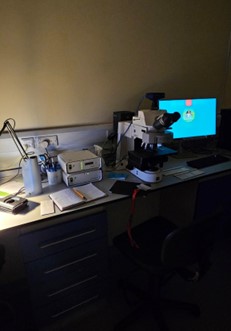By Anmoyul Mohon, MSci Pharmacology
Hello, I’m Anmoyul Mohon, currently in my third year of studying pharmacology (4 year degree). As part of the MSci programme, I am required to complete a one-year lab placement in a pharmacology-related field. This opportunity allows pharmacology students to transition from a BSc to an MSci by securing a placement in a lab. During this time, I gained research experience while also completing distance learning modules unrelated to my placement responsibilities. These lab placements can be in either industry or academia and either at KCL or outside the institution.
Due to my interest in neuropharmacology and immunopharmacology, I decided to spend my placement year in a neuroscience lab focusing on pain research. This allows me to move away from the typical wet lab setting and apply my previous experience from coursework and summer internships to somatosensory and cognitive neuroscience work.
One difference I’ve noticed between academic and industry placements is the flexibility of scheduling. In academia, we have a series of tasks to complete, and it’s up to us to organise our experiments and schedule accordingly. This includes determining whether an experiment requires a partner or can be done alone, as well as accounting for time needed for incubation in immunohistochemistry (IHC) or habituation in animal work.
Today, I’ll give you an insight into a typical day of a neuropharmacology placement student conducting academic research at the WOLFSON Center of Age-related Disease, specifically focusing on pain research. Keep in mind that I’m nearing the end of my placement, so most of my experiments are either completed and being processed or will be finished tomorrow.
My day usually starts around 7:30 am, and the first thing I do is work on my dissertation for a few hours. Then, around 11 am, I head to the lab where I typically spend two hours conducting experiments, preferably in the wet lab. This requires more attention, note-taking, and calculations. Today, I had to perform immunohistochemistry on mice brain sections to observe the distribution of peptidergic and nonpeptidergic sensory neurons involved in pain sensation.


As a tip for future biosciences researchers, especially those considering a PhD, multitasking is crucial. So, once I finish my morning experiment, I rush to the Biological Service Unit by 1 pm. There, I retrieve the animal rodents, ranging from zebrafish to rats, needed for my afternoon experiment. I leave them in their cages for an hour and take a lunch break. Afterwards, I continue with my experiment, which involves measuring the response of transgenic mice to different intensities of low-level pain.
Later on, I attend a lab meeting where one of our lab’s PhD students presents their research on pain prevalence in rheumatoid arthritis patients. We also celebrate the offer of a PhD position to our lab’s research assistant for the upcoming academic year.
On other days, I might not conduct many experiments and instead focus on data processing or engage in additional placement activities. As part of my King’s Scholar role, I teach math to secondary school students as part of a KCL program, which allows me to earn some extra money on the side as well as some other activities like this blog as part of my Money Mentor role.
I hope this has given you a great insight into what a placement might look like as a pharmacology student.
